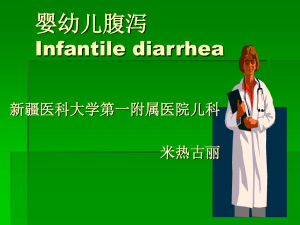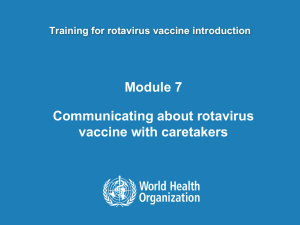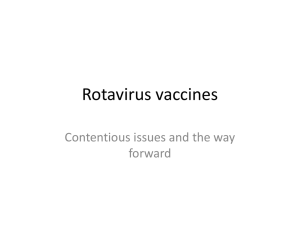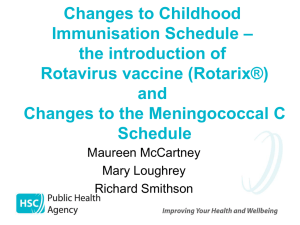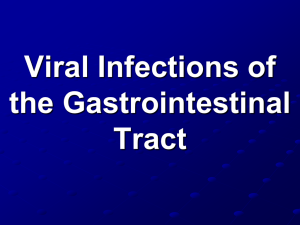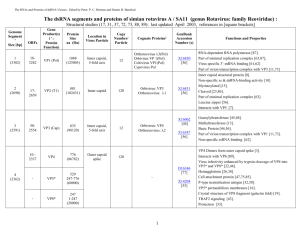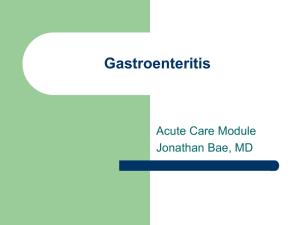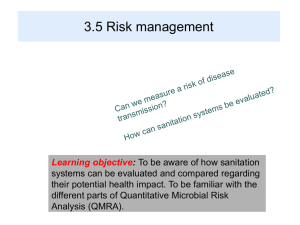Slides from JHU
advertisement
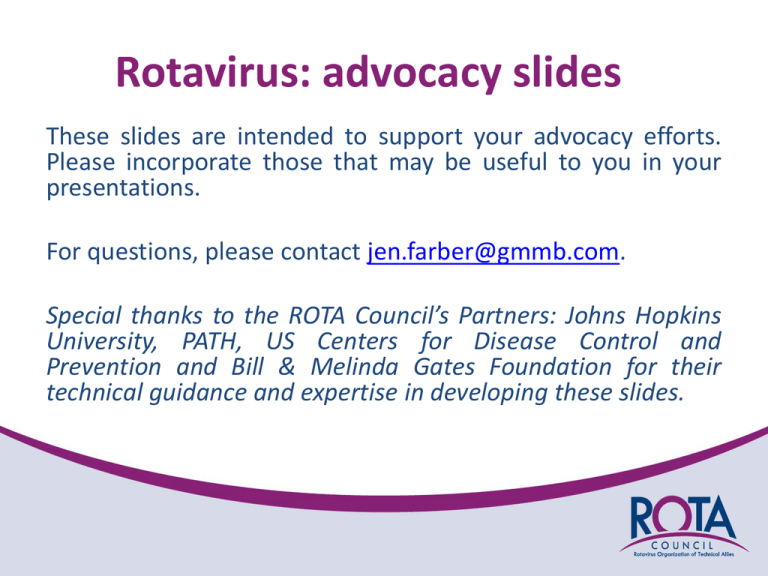
Rotavirus: advocacy slides These slides are intended to support your advocacy efforts. Please incorporate those that may be useful to you in your presentations. For questions, please contact jen.farber@gmmb.com. Special thanks to the ROTA Council’s Partners: Johns Hopkins University, PATH, US Centers for Disease Control and Prevention and Bill & Melinda Gates Foundation for their technical guidance and expertise in developing these slides. Diarrhea Diarrhea: global problem Diarrhea is a leading cause of death in children under age 5, responsible for nearly 800,000 deaths1 It’s common. More than 1.7 billion cases occur annually in children under 51 It can cause severe dehydration and lead to hospitalization or death1 Diarrhea has lasting repercussions for children2 • Major contributing factor to malnutrition • Leads to growth delays • Children are 8.5 more times likely to die from any cause after an episode 1WHO Diarrheal Disease Factsheet 2013 Enteric Multicenter Study (GEMS), Kotloff, Lancet, May 2013 2Global Diarrhea: a leading cause of child death Neonatal diarrhea Measles 1% 1% AIDS Meningitis 2% 2% Injury 5% Malaria 7% Neonatal (excluding diarrhea) 40% Diarrhea 10% Pneumonia 14% Other 18% Child Health Epidemiology Reference Group; Liu, Lancet, 2012 Diarrhea causes 10% of deaths in children under 5 ~800,000 child deaths attributed to diarrhea Diarrhea: devastating impact Global Enteric Multicenter Study (GEMS), Kotloff, Lancet, May 2013 Diarrhea: causes are clear Rotavirus is 1 of 4 pathogens causing the majority of moderate-tosevere diarrhea in children under age 5 Rotavirus is the #1 cause of diarrhea in infants (0-11 months) GEMS, Kotloff, Lancet, May 2013 Diarrhea: hospitalizations in children Rotavirus the leading cause of hospitalizations for diarrhea in children Rotavirus causes ~40% of all diarrhea hospitalizations in children under 5 Parashar, Emerging Infections Diseases, 2006 Parashar, EID, 2003 Rotavirus Other Rotavirus Rotavirus: common and severe Most common cause of severe diarrhea among children1 Highly contagious and resilient2 Improvements in hygiene, sanitation and drinking water do not adequately prevent rotavirus1 Almost every child is infected by age 5, rich or poor, regardless of where they live1 Most infections occur in very young children1 1WHO Rotavirus Position Paper, 2013 Rev Infect Dis, 1991 2Ansari, Rotavirus: treatment and prevention Without access to treatment for the severe dehydration it can cause, rotavirus can be a death sentence • Rotavirus cannot be treated with antibiotics or other drugs • Prompt treatment with oral rehydration therapy (ORT) can be effective in treating mild infections • Many of the world’s poorest children do not have access to ORT, despite the fact that it is effective and inexpensive • Rotavirus prevention by vaccination is key to improving child survival 1 Santosham, Lancet, 2010 ORT coverage is only in ~30% of places where the most diarrhea deaths occur1 Rotavirus: deadly Rotavirus is the leading cause of death due to diarrhea in young children More than 1,200 children die each day from rotavirus Responsible for 5% of all deaths in children under 5 95% of rotavirus deaths occur in low-income countries eligible for GAVI support Tate, Lancet, 2011 Estimated global rotavirus deaths, 2008 Total deaths = 453,000 Rotavirus deaths: top 10 countries India 98,621 Nigeria 41,057 Pakistan 39,144 DRC 32,653 Ethiopia 28,218 Afghanistan Uganda 25,423 10,637 Indonesia 9,970 Bangladesh 9,857 Angola 8,788 WHO. Estimated rotavirus deaths for children under 5 years of age in 2008 Five countries (India, Nigeria, the Democratic Republic of the Congo, Ethiopia and Pakistan) accounted for more than half of all rotavirus deaths in children under age five in 2008 14 Rotavirus: devastating burden Responsible for millions of hospitalizations and clinic visits annually Accounts for approximately 40% of all diarrhea-related hospitalizations Parashar, Emerging Infections Diseases, 2006 Parashar, EID, 2003 Sample photo provided by Johns Hopkins University/IVAC, you can also include your own References • • • • • • • • Ansari SA, Springthorpe VS, Sattar SA. Survival and vehicular spread of human rotaviruses: possible relation to seasonality of outbreaks. Reviews of infectious diseases. 1991; 13(3): 448-61. Atherly D, Lewis K, Tate J et al. Projected health and economic impact of rotavirus vaccination in GAVI-eligible countries: 2011–2030. Vaccine. 30S (2012) A7– A14. Armah G, Sow S, Breiman R, et al. Efficacy of pentavalent human-bovine reassortant rotavirus vaccine against severe rotavirus gastroenteritis in sub-Saharan Africa: a randomized, double-blind, placebo-controlled trial. The Lancet. 2010;376(9741):606-614. Buttery JP, Lambert SB, Grimwood K, et al. Reduction in rotavirus-associated acute gastroenteritis following introduction of rotavirus vaccine into Australia’s National Childhood vaccine schedule. Pediatric Infectious Disease Journal. 2011;30(suppl 1):S25–S29. Buttery JP, Danchin MH, Lee KJ, Carlin JB, McIntyre PB, Elliott EJ, et al. Intussusception following rotavirus vaccine administration: post-marketing surveillance in the National Immunization Program in Australia. Vaccine. 2011;29(16):30613066. CDC. Rotavirus vaccines and intussusception in the Vaccien Safety Datalink (VSD). http://www.cdc.gov/vaccines/acip/meetings/downloads/slides-jun-2013/02-Rotavirus-Weintraub.pdf. Published 2013. Accessed 29 July 2013. Cortese MM, Tate JE, Simonsen L, Edelman L, Parashar UD. Reduction in gastroenteritis in United States children and correlation with early rotavirus vaccine uptake from national medical claims databases. Pediatric Infectious Disease Journal. 2010;29:489–494. References • • • • • • • do Carmo GM, Yen C, Cortes J, Siqueira AA, de Oliveira WK, Cortez-Escalante JJ, et al. Decline in diarrhea mortality and admissions after routine childhood rotavirus immunization in Brazil: a time-series analysis. PLoS Medicine. 2011;8(4):e1001024. FDA. Risk of intussusception after rotavirus vaccination: results of a PRISM study. http://www.cdc.gov/vaccines/acip/meetings/downloads/slides-jun-2013/04-Rotavirus-Yih.pdf. Published 2013. Accessed 29 July 2013. Haber P, Patel M, Izurieta HS, Baggs J, Gargiullo P, Weintraub E, Cortese M, Braun MM, Belongia EA, Miller E, Ball R, Iskander J, Parashar UD. Postlicensure monitoring of intussusception after RotaTeq vaccination in the United States, February 1, 2006, to September 25, 2007. Pediatrics; 2008:121(6):1206-12. Kotloff KL, Nataro JP, Blackwelder WC, Nasrin D, Farag TH, Panchalingam S, et al. Burden and aetiology of diarrhoeal disease in infants and young children in developing countries (the Global Enteric Multicenter Study, GEMS): a prospective, casecontrol study. Lancet. 2013. Liu L, Johnson HL, Cousens S, Perin J, Scott S, Lawn JE, et al. Global, regional, and national causes of child mortality: an updated systematic analysis for 2010 with time trends since 2000. Lancet. 2012; 379(9832): 2151-61. Madhi S, Cunliffe N, Steele D et al. Effect of human rotavirus vaccine on severe diarrhea in African infants. The New England Journal of Medicine. 2010;362(4):289-298. Parashar U, Hummelman E, Bresee J, et al. Global illness and deaths caused by rotavirus disease in children. Emerging Infectious Diseases. 2003 May; 9(5):565–572. References • • • • • • • • • • Parashar UD, Gibson CJ, Bresse JS, et al. Rotavirus and severe childhood diarrhea. Emerging Infectious Diseases. 2006;12:304–306. Patel MM, Glass R, Desai R, Tate J, Parashar UD. Fulfilling the promise of rotavirus vaccines: how far have we come since licensure? Lancet Infect Dis 2012; 12; 561-70 Patel M, Richardson V, et al. Intussusception risk and health benefits of rotavirus vaccination in Mexico and Brazil. The New England Journal of Medicine. 2011;364(24):2283- 2292. Patel MM, Patzi M, Pastor D, Nina A, Roca Y, Alvarez L, et al. Effectiveness of monovalent rotavirus vaccine in Bolivia: casecontrol study. BMJ. 2013;346:f3726 Patel MM, Santosham M, Tate, J. Preventing Rotavirus Disease in the Developing World: Issues, Opportunities, and Challenges. Medscape, December 2012. http://www.medscape.org/viewarticle/776009 Richardson V, Hernandez-Pichardo J, Quintanar-Solares M, et al. Effect of rotavirus vaccination on death from childhood diarrhea in Mexico. The New England Journal of Medicine. 2010;362(4):299–305. Rheingans RD, Antil L, Dreibelbis R, et al. Economic costs of rotavirus gastroenteritis and cost-effectiveness of vaccination in developing countries. JID 2009;200 (Supplement 1):S16–S27. Ruiz-Palacios GM, Perez-Schael I, Velazquez FR, Abate H, Breuer T, Clemens SC, et al. Safety and efficacy of an attenuated vaccine against severe rotavirus gastroenteritis. N Engl J Med. 2006; 354(1): 11-22. Santosham M, Chandran A, Fitzwater S, et al. Progress and barriers for the control of diarrhoeal disease. The Lancet. 2010; 376: 63–67. Shui IM, Baggs J, Patel M, Parashar UD, Rett M, Belongia EA, Hambidge SJ, Glanz JM, Klein NP, Weintraub E. Risk of intussusception following administration of a pentavalent rotavirus vaccine in US infants. JAMA; 2012: 307(6):598-604. References • • • • • • • • • • Soares-Weiser K, Maclehose H, Bergman H, Ben-Aharon I, Nagpal S, Goldberg E, Pitan F, Cunliffe N. Vaccines for preventing rotavirus diarrhoea: vaccines in use. Cochrane Database Syst Rev.; 2012:11:CD008521. Steele AD, Neuzil KM, Cunliffe NA, Madhi SA, Bos P, Ngwira B, et al. Human rotavirus vaccine Rotarix provides protection against diverse circulating rotavirus strains in African infants: a randomized controlled trial. BMC Infect Dis. 2012; 12: 213. Tate JE, Burton AH, Boschi-Pinto C, Steele D, et al. 2008 estimate of worldwide rotavirus-associated mortality in children younger than 5 years before the introduction of universal rotavirus vaccination programmes: a systematic review and metaanalysis. The Lancet. Published online October 25, 2011. Vesikari T, Matson DO, Dennehy P, Van Damme P, Santosham M, Rodriguez Z, et al. Safety and efficacy of a pentavalent human-bovine (WC3) reassortant rotavirus vaccine. N Engl J Med. 2006; 354(1): 23-33. WHO. Diarrhoeal disease. 2009 [cited 2011 September 28]; Available from: http://www.who.int/mediacentre/factsheets/fs330/en/index.html WHO. Meeting of the immunization Strategic Advisory Group of Experts, April 2009 – conclusions and recommendations. Weekly Epidemiological Record. 2009; 84(23):232-236. WHO. Rotavirus vaccines: WHO position paper – January 2013. Wkly Epidemiol Rec. 2009; 88(50): 49-64. WHO: Rotavirus vaccine update 2012. Available from: http://www.sabin.org/sites/sabin.org/files/Fatima%20Serhan.pdf WHO. Estimated rotavirus deaths for children under 5 years of age. Available from: http://www.who.int/immunization_monitoring/burden/rotavirus_estimates/en/ Zaman K, Dang DA, Victor J, et al. Efficacy of pentavalent rotavirus vaccine against severe rotavirus gastroenteritis in infants in developing countries in Asia: a randomised, double-blind, placebo-controlled trial. The Lancet. 2010;376(9741):615-623.

